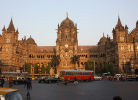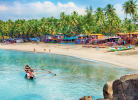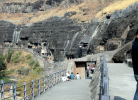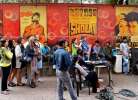Shri Shirdi Sai Baba Temple, Maharashtra
Visitor Information:
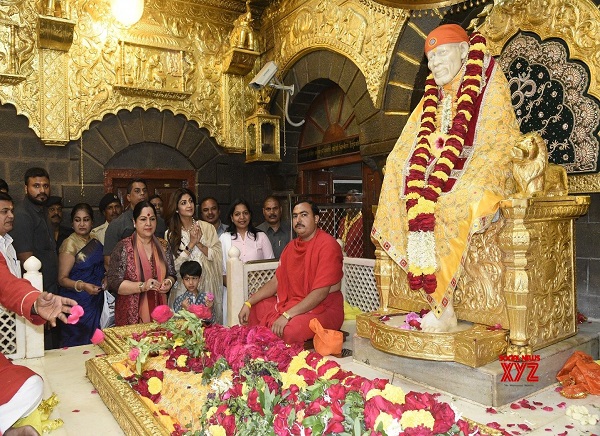
-
Famous For Religious, Worship
-
Fee Free but applicable for VIP Tickets
-
Visiting Time 4:00 AM to 11:15 PM
-
Duration of Visit NA
The temple of Sai Baba in the town of Shirdi is an important pilgrimage site. On average, the temple receives more than 25,000 devotees every day.
This town is said to be the home of Sai Baba, where he arrived in the mid of the 19th century and stayed there for 60 years. The temple is the resting place of his earthly remains. Today, people visit this temple for its spiritual beauty and serenity.
Location of Shirdi Sai Baba Temple
This temple is located in the town of Shirdi of Ahmednagar of Maharashtra.
History of Shirdi Sai Baba Temple
Sai Baba visited Shirdi and stay back in the village teaching, preaching and praying for several decades. Upon his request, after his death, the villagers buried his mortal remains in a designated place and built the Samadhi Mandir on it.
A large marble statue of Sai Baba in sitting position is constructed right next to the Samadhi in 1954.
The temple holding his tomb was constructed at a large private house, which was built when he was alive. Sai Baba planted saplings around the home and watered them. The house was used as a rest home for the saint and it was built by a multimillionaire from Nagpur, Gopalrao Booty.
When the saint fell ill, he stayed back in the house and he was buried in the house, after his death. Later, the actual temple was built which was twice the size of the house.
Many changes were made to the temple over a period of time to accommodate the growing population.
Architecture of Shirdi Sai Baba Temple
Once you enter the temple, you will find a large hall filled with photographs of the life of Sai Baba and the temple. On the left to the hall, a small room holds memorabilia of the saint like his cooking utensils, stick and so on.
Walk past the hall, you will find the main idol and the Samadhi.
Right next to the temple, there is a large stone under a tree. It is said that Sai Baba used to sit on the stone to meditate and preach. A large portrait of the saint is placed on the stone.
A small lamp is kept burning since the construction of the temple. This region is called Dwarkamayee Masjid or Dwarkamai. This is the only religious site where you can find a mosque inside a temple.
You can find many items near the stone that was used by the saint. This structure has stone walls and an iron roof.
The temple complex also holds Chavadi which is a small platform under a neem tree. This is the place where Sai Baba rest, while he was alive. It is said that the leaves of this tree have a sweet taste.
Significance of Shirdi Sai Baba Temple
This temple is the main pilgrimage site of the followers of Sai Baba. This temple holds his earthly remains, items that he used every day and other articles of his possession.
The Samadhi is built with white marble and the main deity of the temple is built with Italian marble. The structure of the temple is specifically kept simple to express the simplicity adorned by the saint during this life.
The marble is chosen for the deity to express that the heart of the saint was as white as the Italian marble.
This temple is one of the richest in the country with abundant donations received from pilgrims and locals. Every week, the temple receives around INR 14 lakhs in just coins. In total cash, the temple receives 2-4 crores per week.
Followers
Sai Baba never associated himself with any religion. He did not appoint any spiritual heir or disciple. However, there are numerous followers and disciples of Sai Baba, who were famous spiritual figures.
The Hindus and Muslims believe that Sai Baba belongs to their religion.
Visiting Timing of Shirdi Sai Baba Temple
The temple is open from 4 am to 11:15 pm and the timings of special rituals are:
| Ritual | Activity | Time | Locaton |
|---|---|---|---|
| Bhupali | Wake up call for the deity | 4:15 Am | N/A |
| Kakad Aarti | First ritual of the day | 4:30 AM | N/A |
| Bhajan | Religious chanting with or without musical instruments | 5 AM | Samadhi Mandir |
| Mangalsnaan | Drenching the deity in water, milk, fruits, and others, as a symbolic bath | 5:05 AM | Samadhi Mandir |
| Shirdi Majhe Pandharpur | Religious Aarti | 5:35 AM | N/A |
| Darshan | Prayer | 5:40 AM | Samadhi Mandir |
| Dhuni Pooja | Bathing the deity in ghee | 11:30 AM | Dwarkamai |
| Afternoon Aarti | Religious Ritual | 12:00 PM | N/A |
| Pothi | Devotional reading, lecture or prayer | 4 PM | Samadhi Mandir |
| Dhoop Aarti | Sunset ritual | At sunset | N/A |
| Bhajan | Devotional songs or cultural programs (takes place during festivals only) | 8:30 PM - 10 PM | Samadhi Mandir |
| Shej Aarti | Night ritual to put the deity to sleep | At sunset | 10:30 PM |
Entry Fee of Shirdi Sai Baba Temple
The temple is open to everyone for free of cost.
VIP Darshan (Paid Entrance)
As mentioned before, the temple is open for all, free of cost. However, the queue would be very long, especially during religious celebration times. Thus, many people choose to book for VIP Darshans. There are two methods to procure VIP darshan tickets:
- The temple’s official website has an online portal to buy tickets. Upon payment, you will receive an identification number or receipt. Show the receipt at Gate 3 and you can enter the VIP queue.
- Reach Gate 1 and you will find a ticket counter. You can buy VIP tickets here and then move to Gate 3. However in this option, there is a high probability of running out of tickets, during special days.
Cost of VIP Darshan
- Morning Aarti – INR 500
- Madhyan Aarti – INR 300
- Dhoop Aarti – INR 300
- Shej Aarti – INR 300
- Quick Darshan – INR 1,500
How to Reach Shirdi Sai Baba Temple
The temple is quite famous and thus, finding transportation to reach the temple is much easier, even if you are visiting during the off-season.
By Flight
If you are traveling by air to Shirdi, the closest airport is Sri Sai Baba Airport, which is located just 15 km away from the temple. you can find daily direct flights fromDelhi, Indore, Chennai, Kolkata, Mumbai, Hyderabad, and Vijayawada.
From the airport, you can find many buses and cabs to reach the temple.
By Road
Shirdi is a little less than 84 km away from Ahmednagar. You can find direct buses (government and luxury coaches) from Mumbai, Aurangabad, Nashik and other destinations to Shirdi.
You can also find cabs directly to the temple from the surrounding regions. However, the traffic in the route would be heavy and the time taken would be longer than other modes of transportation.
By Train
The city of Shirdi has its own railway station, which receives trains from many major cities around the country including Delhi, Mumbai, Chennai, Hyderabad, and others.
By Helicopter
Many private service providers offers helicopter service between Shirdi and Juhu aerodrome of Mumbai. This is the costliest option of transportation and many service providers also offer packages, which include traveling inside Shirdi in road transportation and visit the temple (VIP darshan).
Best Time To Visit Shirdi Sai Baba Temple
The temple is at prime beauty throughout the year and thus, the temple experiences tourists and pilgrims throughout the year. The best time to visit depends on your reason for the visit.
If you are looking for a colorful time in the temple, it is best to visit during any festival like Diwali, Dussehra, Gudi Padwa, Guru Purnima, Holi and others. The September and October months hold the maximum number of festivals.
If you are planning to visit and enjoy the serenity of the temple without crowd, it is best to visit on Wednesday, Monday, and Tuesday. Especially between 12 noon and evening, there will be only a handful of people inside the temple. If you are visiting for special rituals or on auspicious days, visit during Wednesday night or Thursday.
On Thursdays, his photograph is taken on a palanquin around the city from the temple for devotees to pray to the photograph and the procession returns back to the temple.
When it comes to climate, the place is hot and humid in summer and, inconvenient for sightseeing in monsoon. Thus, winter is the best time to visit the temple. Winter starts by early October and ends by March.
Where to Stay Shirdi Sai Baba Temple
There are numerous hotels, guesthouses, and lodges around the temple. The temple also has a few rooms for accommodation.
However, the availability of those rooms are quite questionable, especially during special days. The accommodations have to be booked at least a month before your visit. An AC room inside the temple complex costs INR 900 and the non-AC room costs INR 200.
Special Festivals To Enjoy in the Temple
Almost all festivals related to Lord Vishnu and other Hindu festivals are celebrated with bliss in the temple. However, the best of all celebrations are the three main festivals namely, Ramnavami (March or April), Vijayadashami (September) and, Guru Purnima (July).
Many programs, cultural celebrations, special rituals, and others take place in the temple and the temple will be open throughout the night, on the previous day. Night bhajans and rituals take place with more celebrations.
Visitor Tips
- Thursdays are the most-crowded days and thus, it is best to avoid that day.
- There is no strict rule for clothing. However, it is better to wear any dress that covers you from neck to below the knee. Decent clothing would be fine.
- If you are not opting for VIP darshan, you might have to wait at least three hours in the queue, especially during special days. Thus, it is best to bring as much water as possible with you.
- With the crowd around you, you are the sole responsible entity for your belongings. If you are traveling with your child, it is best to avoid crowded days.
- If you are looking for wheelchair assistance, visit Gate 5 and you can collect them, free of cost.
- Do you know that Shirdi is the country’s largest fruit exporter of grapes, pomegranates, and guava? Try fresh fruits, while you are in town.
- Only flowers are accepted by the priest. Any other material given to the deity will be placed in the ritual and returned back to the devotee.



















